BEP CZone #1, “distributed power”?
I’ve been looking through a lot of material on BEP’s new CZone system, and finding it impressive. But its descriptive subtitle — “Networked Control and Monitoring System” — seems a tad vague to me. In fact, Simrad changed that to “digital switching” when they showed off their nifty CZone integration with the NSE series (covered briefly in a Miami Show entry). It does seem like the handful of manufacturers who dare to compete in this complex, and potentially hairy, niche can’t agree about what to call it, but I like “distributed power”. You can see why in the simplified CZone sample diagram above; like the competition, those OI modules efficiently distribute an electrical system’s core power feed and circuit protection functions to where they’re needed, while networking the switching and much more. There is no central breaker panel on this boat, and a lot less wire. The following diagrams tell more about the concept…
Below is BEP’s simplified diagram of a traditional wiring system. Extend it to accommodate a vessel with as many power needs as my 37′ Gizmo — which is actually fairly moderate these days — and, man, there’s a lot of cable runs, but not very much control of that power, let alone monitoring and integration…
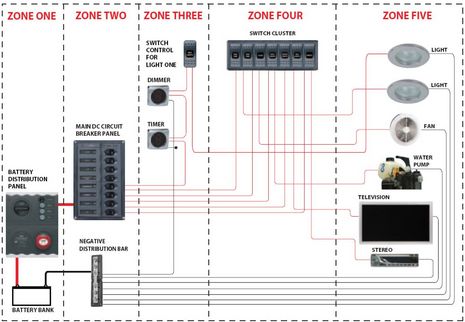
Now here’s the same simple system done with CZone. Note how that Output Interface (OI) module, which contains electronic circuit breakers (aka MOSFETs), is the heart of the matter. Other distributed power systems like OctoPlex, DNA/DSS, Capi2, etc. also have elements like the CZone’s Signal Interface — which can connect to all sorts of switches, tank senders, and other sensors — and the more focused Switch Interface, as well as the Meter and Motor Interface modules not shown here. Of course the sexiest part is CZone’s color display. Unfortunately I don’t have good images of that yet, but…
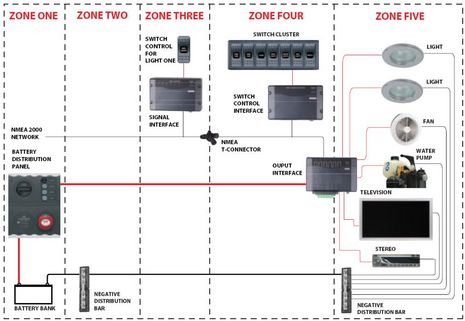
I did just get some screen shots of an NSE running CZone. And while I have a lot more to say about this and the other distributed power systems — including some late breaking news which suggests why anyone should be darn careful about getting into a system like this — for now let’s just enjoy the possibilities. This first screen shows some of CZone’s many monitoring abilities…
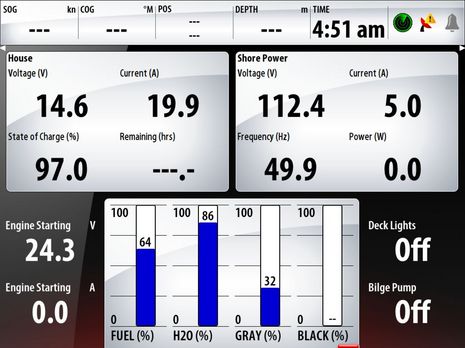 While this next one illustrates some very slick control functions. As I understand it those buttons — which can obviously switch all sorts of devices around a boat with one click — are programmed either with a PC or the CZone’s dedicated display, and then populate the NSE automatically. At any rate, as you can see, BEP has a case for calling CZone networked monitoring and control, but I don’t think it would work like this without the distributed power system behind the scenes. BEPmarine.com seems just part way to offering a lot of CZone information right now, but you can download the brochure PDF here. More to come.
While this next one illustrates some very slick control functions. As I understand it those buttons — which can obviously switch all sorts of devices around a boat with one click — are programmed either with a PC or the CZone’s dedicated display, and then populate the NSE automatically. At any rate, as you can see, BEP has a case for calling CZone networked monitoring and control, but I don’t think it would work like this without the distributed power system behind the scenes. BEPmarine.com seems just part way to offering a lot of CZone information right now, but you can download the brochure PDF here. More to come.



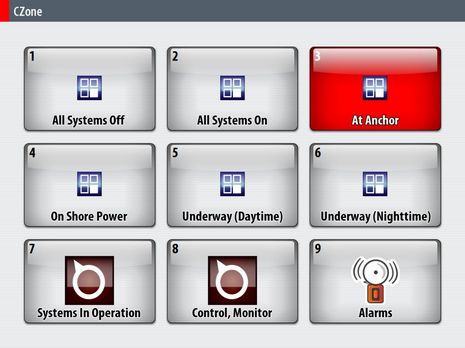
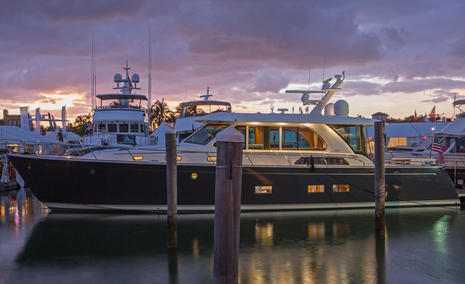
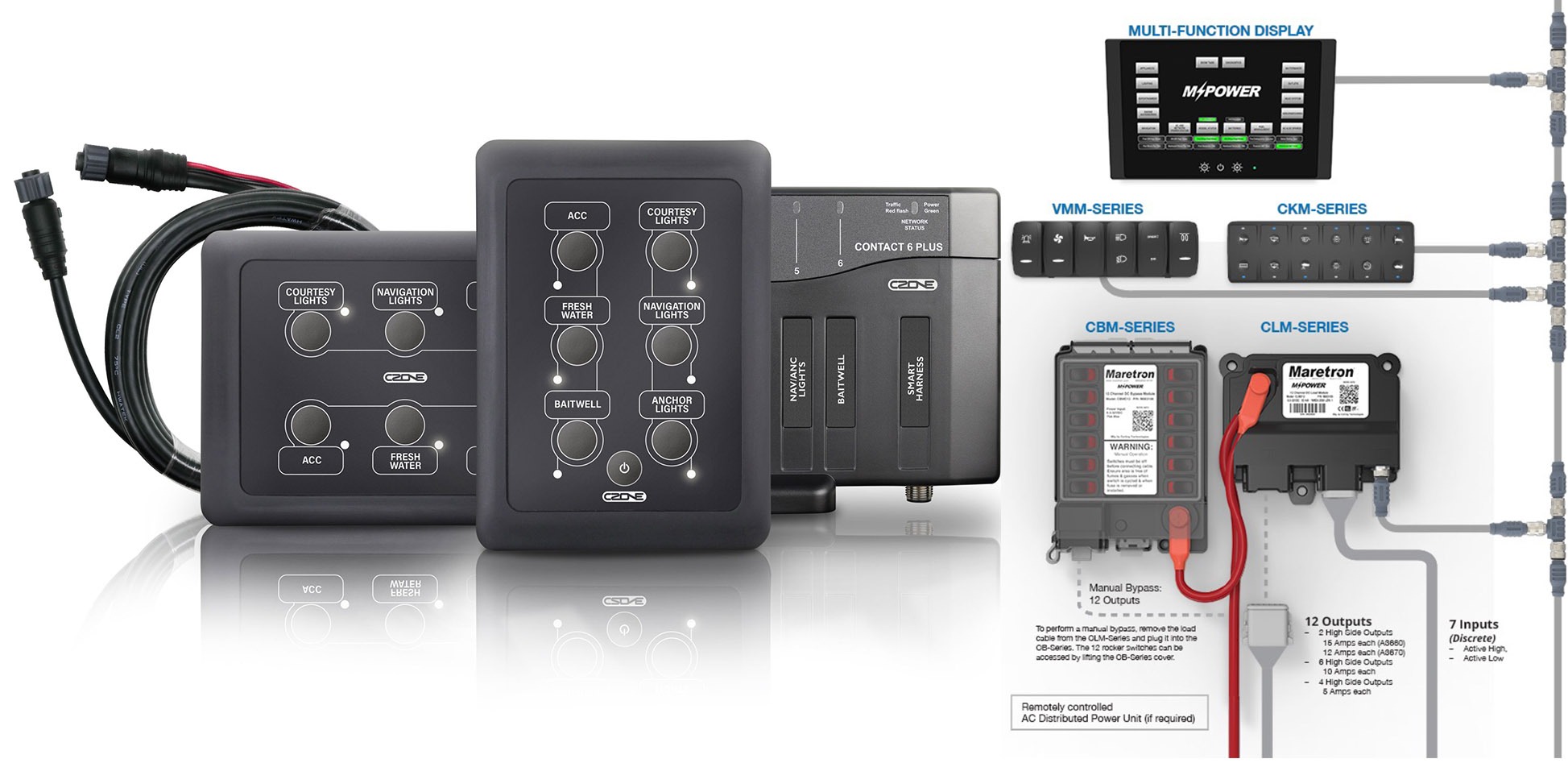









I didn’t get into the NMEA 2000 aspect of CZone in this entry, but note that it’s just “compliant” (which means little), not certified. I’m reserving judgement, however; I don’t think NMEA has even published a set of power-related PGNs yet (though imminent), and, besides, this sort of system is out there on the very tip of the bleeding edge. It may turn out that a network including this level of control and complexity is best done with only brands which promise compatibility.
Nigel Calder was pretty into this as the future of power distribution at the Seattle Boat Show 2 years ago.
In addition to the enourmous weight savings and great ease at adding adding additional devices in your boat, what I also like about these systems is that they constantly monitor the power draw of each circuit and use that for some specialized functionality.
Example #1: when you turn on your navigation lights, by watching current draw, it can be determine that your bulb has burned out.
Example #2: by counting the run time of your bilge pump, it can be determined that its abnormally high and set off an alarm
Don’t keep us in suspense, Ben! Why must we be darn careful about getting into a 3-wire system?
It appears this BEP system uses N2K as the primary data buss? If so this it the first distributed switching system that does so (that I have seen at least). Seems all the others have their own data wire requirement. I like that.
Networked distributed switching IS the future. Its been around for a while (just new to marine industry).
Adam, A significant distributed power system NOT MENTIONED in this entry is purportedly going out of production in a few weeks, possibly leaving a bunch of boats without spare parts and customer support. I know this to be at least partially true, but am giving the company a couple more days to come up with “the rest of the story.”
If the worst is true, it’s bad news for the owners of those systems. A full on distributed power system is everywhere in a boat and may require very specific parts and expertise to troubleshoot and repair. And must be a bear to replace.
For the same reasons, I’d also be quite cautious about a system that isn’t well proven in the field. Distributed power is very seductive, but I’d sure want a solid product from a solid company.
Ben,
Not sure if you have mentioned here before, but Mastervolt has quietly released its own distributed switching systems.
Mastervolt has always been regarded as high quality and very good support. And the brand has been around for a while.
I’d be interested to hear any information you may have on their system.
http://www.mastervolt.com/index2.php?lang=2&cat_id=17&tekst_id=96&utm_source=website&utm_medium=redirects&utm_campaign=masterbus
Large scale marine distributed power systems:
http://www.schneider-electric.com/sites/corporate/en/solutions/business_segments/marine/marine-solutions/the-power-management-systems.page
Success stories:
http://www.schneider-electric.com/sites/corporate/en/solutions/business_segments/marine/marine-solutions/the-power-management-systems.page
Lightning strikes???
In the event of lightning strike (disabled electronics but electrics work), most (or maybe even all) of these products let you manually operate the power switches. Instead of being at a centralized panel, you need to go to the individual hubs where devices are individually wired, to operate a manual switch lever on each electronically controlled switch.
E-T-A Powerplex marine power distribution system
http://www.e-t-a.com.au/au_powerplex.html
Brochure and Success story
http://www.e-t-a.com.au/fileadmin/user_upload/Ordnerstruktur/pdf-Dateien/Info/GF_Prospekte/SGF_englisch/B_PowerPlex_e_050608B.pdf
http://www.e-t-a.com.au/au_latest_news.html